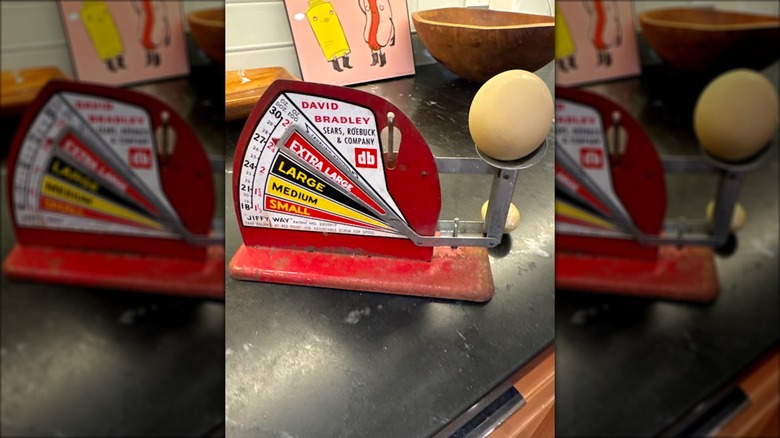The Old-School Kitchen Gadget That's Become Completely Obsolete Over The Years
We may receive a commission on purchases made from links.
Whether someone is scrambling them in butter, folding them into an omelet, or looking up tips and tricks for perfect poached specimens, lots of folks enjoy eggs. Those same folks, however, likely don't put too much thought into the grading of eggs. In America, eggs are commercially graded by quality (AA, A, and B) and sorted by size. The print on your carton of eggs will not only tell you how old your grocery store eggs happen to be, but also their grade and size. Before the USDA got involved in standardizing the egg grading process on a national scale — to say nothing of washing them, which many Europeans don't do and therefore don't have to refrigerate their eggs — folks with home coops had a gadget called an egg grader. Also known as an egg scale, it weighed the eggs their chickens laid.
At its heart, an egg grader is just a specialized scale. The most basic models did nothing more than weigh eggs in ounces, while fancier, more useful models assigned the eggs a size, ranging from "small" to "extra large." This last step was achieved by means of colored ranges on the weights or a series of metal fins that rose up during the weighing of the egg. These graders were sold in farm and home goods catalogs in the first half of the 20th century. Of course, as fewer and fewer people bought their eggs from local farmers or simply got them out of their own chicken coop, and as grocery store eggs began to take over the culinary world, the usefulness of egg graders fell off sharply, and this tool became a relic of the past.
What replaced egg graders for home use?
Today, eggs aren't sold simply on the basis of size like they were 100 years ago. A grading system has replaced the old classifications, and although eggs are still sorted by size for grocery store sale, home hen owners have to grade the eggs only, as grade "B" eggs are usually saved for processing. Today, if you own fewer than 3,000 laying hens (above that, regulations are different), all you really need is a candling tester light to examine the interior of the egg for the size of the air cell, the condition of the white and the yolk, and the presence of any blood or meat spots. The light will also clearly illuminate any cracks in the shell that could allow contaminants to get inside the egg.
Today's egg graders are industrial machines that sort eggs by grade and would be most useful for someone running a commercial enterprise, as these devices are large and expensive. There really isn't an everyday use for the quaint egg graders or egg scales of yesteryear, although they might make cute kitchen décor items if your taste runs towards the rustic. It might surprise you to learn that some farm supply stores still sell egg scales, but these are most useful for the home cook engaging in baking pursuits, when a certain-sized egg is called upon for a recipe. They are less likely to be useful for officially labeling eggs for sale, however.

